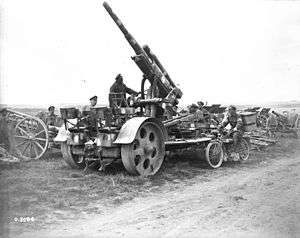8.8 cm Flak 16
| 8.8 cm Flak 16 | |
|---|---|
|
8.8 cm Flak 16 cannon | |
| Type | Anti-aircraft gun |
| Place of origin | German Empire |
| Service history | |
| In service | 1917-1918 |
| Used by | German Empire |
| Wars | World War I |
| Production history | |
| Designed | 1917 |
| Manufacturer | Krupp |
| Specifications | |
| Barrel length | 396 cm (156 in) |
|
| |
| Shell | Fixed |
| Shell weight | 9.4 kilograms (21 lb) |
| Caliber | 88 mm (3.46 in) |
| Barrels | One |
| Traverse | 360° |
| Muzzle velocity | 785 m/s (2,575 ft/s) |
The 8.8 cm Flak 16 was a German 88 mm anti-aircraft artillery gun from World War I, the forerunner of the later 88 mm guns of World War II. It`s contemporary name was the 8.8cm K.Zugflak L/45.
Development
Early anti-aircraft artillery guns of World War I were primarily adaptations of existing medium-caliber weapons, mounted to enable fire at higher angles. By 1915, the German military command realized that these were useless for anything beyond deterrence, even against vulnerable balloons and slow-moving aircraft.[1] With the increase of aircraft performance, many armies developed dedicated AA guns with a high muzzle velocity – allowing the projectiles to reach greater altitudes. The first such German gun, the Flak 16, was introduced in 1917, using the 88 mm caliber, common in the Kaiserliche Marine.[1]
References
- 1 2 Westermann, Edward B. (2005–2009) [2001]. Flak: German Anti-aircraft Defenses 1914-1945. Modern War Studies. University Press of Kansas. pp. 19, 36–38, 44, 53, 58, 83, 90, 108, 128–129. ISBN 9780700614202.
